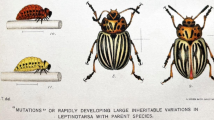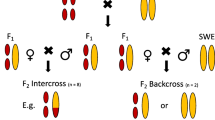Abstract
In Culex pipiens L. eight lines with X-ray induced reciprocal translocations and one line with an inversion have been analysed. In such aberrations which are inherited like sex-linked factors, the smallest chromosome is always involved. The sex determining factors M and m respectively are situated on this small chromosome. — The pericentric inversion described here behaves like an autosomal factor and causes semisterility both in females and males due to crossing-over within the inverted region. It is shown that the chromosome of intermediate size carries this inversion and that it belongs to the same linkage group 2 as the eye color mutation ruby. The correlation of linkage groups with chromosomes of the mosquito Culex pipiens is the following: Linkage group 1 bears the sex-factors M and m resp. and the sex-linked genes and is the smallest chromosome (I). Linkage group 2 with the eye color mutation ruby is identical with the chromosome of medium size (II). Linkage group 3 with the male-limited mutation kps is correlated with the longest chromosome (III) (Zusammenfassung see p. 50)
Zusammenfassung
Die Numerierung der drei Koppelungsgruppen von Culex pipiens L. (Laven, 1967b) stimmt mit der bisherigen auf der Größe der Chromosomen beruhenden cytologischen Numerierung (Rai, 1963; Dennhöfer, 1968) überein.
Das kurze Chromosomenpaar (I) trägt die geschlechtsbestimmenden Faktoren M bzw. m und die geschlechtsgekoppelten Gene der 1. Koppelungsgruppe.
Das mittellange Paar (II) entspricht der 2. Koppelungsgruppe, der die Augenfarbmutation ruby (Iltis, Barr, McCelland und Myers, 1965) angehört. Die ungefähre Lokalisierung dieses Allels wird diskutiert.
Das längste der Homologenpaare (III) ist der 3. Koppelungsgruppe gleichzusetzen, der z. B. die männchenbegrenzte Palpenmutation kps (Laven, 1955, 1957) angehört.
Similar content being viewed by others
Literatur
Acton, A. B.: Crossing over within inverted regions in Chironomus. Amer. Naturalist 90, 63–65 (1956).
Alexander, M. L.: The effect of two pericentric inversions upon crossingover in Drosophila melanogaster. Univ. Texas Publ. 5204, 219–226 (1952).
Baker, R. H., Sakai, R. K., Mian, A.: Linkage group-chromosome correlation in Culex tritaeniorhynchus. Science 171, 585–587 (1971a).
Baker, R. H., Sakai, R. K., Mian, A.: Linkage group-chromosome correlation in a mosquito. Inversions in Culex tritaeniorhynchus. J. Hered. 62, 31–36 (1971b).
Bauer, H., Demerec, M., Kaufmann, B. P.: X-ray induced chromosomal alterations in Drosophila melanogaster. Genetics 23, 610–630 (1938).
Beermann, W.: Inversions-Heterozygotie und Fertilität der Männchen von Chironomus. Chromosoma (Berl.) 8, 1–11 (1956).
Bhalla, S. C.: Cross-over suppressors and sterility in the yellowfever mosquito, Aedes aegypti. Mosquito News 30, 452–456 (1970a).
Bhalla, S. C.: Paracentric inversions and detection of sex linked recessive lethals in Aedes aegypti. Canad. J. Genet. Cytol. 12, 635–650 (1970b).
Callan, H. G., Montalenti, G.: Chiasma interference in mosquitoes. J. Genet. 48, 119–134 (1947).
Carson, H. L.: The selective elimination of inversion dicentric chromatids during meiosis in the eggs of Sciara impatiens. Genetics 31, 95–113 (1946).
Catcheside, D. G.: The effect of X-rays dosage upon the frequency of induced structural changes in the chromosomes of Drosophila melanogaster. J. Genet. 36, 307–320 (1938).
Curtis, C. F.: A possible genetic method for the control of insect pests, with special reference to tsetse flies (Glossina ssp.). Bull. entomol. Res. 57, 509–523 (1968).
Dennhöfer, L.: Die Speicheldrüsenchromosomen der Stechmücke Culex pipiens. I. Der normale Chromosomenbestand. Chromosoma (Berl.) 25, 365–376 (1968).
Dobzhansky, T.: Translocations involving the third and the fourth chromosomes of Drosophila melanogaster. Genetics 15, 347–399 (1930).
Dobzhansky, T.: The decrease of crossing over observed in translocations and its probable explanation. Amer. Naturalist 65, 214–232 (1931).
Freire-Maia, N.: Pericentric inversions in Drosophila. DIS 28, 118–119 (1954).
Gilchrist, B. M., Haldane, J. B.: Sex-linkage in Culex molestus. Experientia (Basel) 2, 372 (1946).
Gilchrist, B. M., Haldane, J. B.: Sex linkage and sex determination in a mosquito, Culex molestus. Hereditas (Lund) 33, 175–190 (1947).
Iltis, W. G., Barr, A. R., McClelland, A. H., Myers, C. M.: The inheritance of yellow-larva and ruby-eye in Culex pipiens. Bull. Wld. Hlth. Org. (1965).
Jost, E., Laven, H.: Meiosis in translocation heterozygotes in the mosquito Culex pipiens. Chromosoma (Berl.) 35, 184–205 (1971).
Kaufmann, B. P.: Induced chromosomal breaks in Drosophila. Cold Spr. Harb. Symp. quant. Biol. 9, 82–91 (1941).
Kunze-Mühl, E.: Untersuchungen über die Verteilung der Bruchstellen natürlicher und strahleninduzierter Chromosomendislokationen bei Drosophila subobscura. Chromosoma (Berl.) 12, 286–309 (1961).
Laven, H.: Strahleninduzierte Mutationen bei Culex pipiens. I. Z. Naturforsch. 10b, 320–322 (1955).
Laven, H.: Vererbung durch Kerngene und das Problem der außerkaryotischen Vererbung bei Culex pipiens. I. Kernvererbung Z. indukt. Abstamm.- u. Vererb.-L. 88, 443–477 (1957).
Laven, H.: Eradication of Culex pipiens fatigans through cytoplasmic incompatibility. Nature (Lond.) 216, 383–384 (1967a).
Laven, H.: Formal genetics of Culex pipiens. In: Genetics of insect vectors of disease (J. W. Wright und R. Pal, eds.), p. 17–65. Amsterdam-London-New York 1967b.
Laven, H.: Genetische Methoden zur Schädlingsbekämpfung. Anz. Schädlingsk. 41, 1–7 (1968).
Laven, H.: Genetische Schädlingsbekämpfung: Produktion von Semisterilität bei der Stechmücke Culex pipiens und Aussichten für die Bekämpfung mit diesem System. Anz. Schädlingsk. 42, 17–19 (1969a).
Laven, H.: Eradicating mosquitoes using translocations. Nature (Lond.) 221, 958–959 (1969b).
Laven, H., Jost, E.: Inherited semisterility for control of harmful insects. I Production of semisterility due to translocation in the mosquito, Culex pipiens L., by X-rays. Experientia (Basel) 27, 471–473 (1971).
Laven, H., Jost, E., Meyer, H., Selinger, R.: Semisterility for insect control. In: Sterility principles for insect control or eradication. IAEA Sym. Wien 1971.
Laven, H., Meyer, H., Bieniok, R., Guille, G., Ohmann, J.: Inherited semisterility for control of harmful insects. II. Degree of sterility and types of translocations in the mosquito Culex pipiens L. Experientia (Basel) 27, 968–969 (1971).
McDonald, P. T., Rai, K. S.: Correlation of linkage groups with chromosomes in the mosquito Aedes aegypti. Genetics 66, 475–485 (1970).
Novitski, E.: The genetic consequences of anaphase bridge formation in Drosophila. Genetics 37, 270–287 (1952).
Panitz, R.: Die cytologischen und genetischen Konsequenzen von Inversionen. Ergebn. Biol. 22, 137–211 (1960).
Philip, U.: An analysis of chromosomal polymorphism in two species of Chironomus. J. Genet. 44, 129–143 (1942).
Rai, K. S.: A comparative study of mosquito karyotypes. Ann. entomol. Soc. Amer. 56, 160–170 (1963).
Sakai, R. K., Baker, R. H., Mian, A.: Linkage group-chromosome correlation in a mosquito. Translocations in Culex tritaeniorhynchus. J. Hered. 62, 90–100 (1971).
Serebrovskii, A. S.: On the possibility of a new method for the control of insect pests. Zool. Zhurn. 19, 618–630 (1940).
Sturtevant, A. H.: A crossover reducer in Drosophila melanogaster due to inversion of a section of the third chromosome. Biol. Zbl. 46, 697–702 (1926).
Sturtevant, A. H., Beadle, G. W.: The relations of inversions in the X chromosome of Drosophila melanogaster to crossingover and disjunction. Genetics 21, 554–604 (1936).
Wagoner, D. E.: Linkage group-karyotyp correlation in the house fly determined by cytological analysis of X-ray induced translocations. Genetics 57, 729–739 (1967).
Wagoner, D. E., Nickel, C. A., Johnson, O. A.: Chromosomal translocation heterozygotes in the house fly. J. Hered. 60, 301–304 (1969).
Wolf, E.: Die Chromosomen in der Spermatogenese einiger Nematoceren. Chromosoma (Berl.) 2, 192–246 (1941).
Author information
Authors and Affiliations
Rights and permissions
About this article
Cite this article
Dennhöfer, L. Die Zuordnung der Koppelungsgruppen zu den Chromosomen bei der Stechmücke Culex pipiens L.. Chromosoma 37, 43–52 (1972). https://doi.org/10.1007/BF00329556
Received:
Accepted:
Issue Date:
DOI: https://doi.org/10.1007/BF00329556




